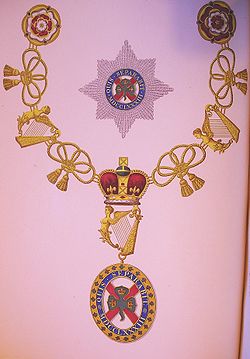
List of Knights of St Patrick
Encyclopedia

George III of the United Kingdom
George III was King of Great Britain and King of Ireland from 25 October 1760 until the union of these two countries on 1 January 1801, after which he was King of the United Kingdom of Great Britain and Ireland until his death...
. The regular creation of knights of Saint Patrick lasted until 1921, when most of Ireland became independent as the Irish Free State
Irish Free State
The Irish Free State was the state established as a Dominion on 6 December 1922 under the Anglo-Irish Treaty, signed by the British government and Irish representatives exactly twelve months beforehand...
. While the Order technically still exists, no knight of St Patrick has been created since 1936, and the last surviving knight, Prince Henry, Duke of Gloucester
Prince Henry, Duke of Gloucester
The Prince Henry, Duke of Gloucester was a soldier and member of the British Royal Family, the third son of George V of the United Kingdom and Queen Mary....
, died in 1974. The Queen
Elizabeth II of the United Kingdom
Elizabeth II is the constitutional monarch of 16 sovereign states known as the Commonwealth realms: the United Kingdom, Canada, Australia, New Zealand, Jamaica, Barbados, the Bahamas, Grenada, Papua New Guinea, the Solomon Islands, Tuvalu, Saint Lucia, Saint Vincent and the Grenadines, Belize,...
, however, remains the Sovereign of the Order. The position of King of Arms of the order was held by Ulster King of Arms; this office still exists, since 1943 it has been combined with Norroy King of Arms. St Patrick
Saint Patrick
Saint Patrick was a Romano-Briton and Christian missionary, who is the most generally recognized patron saint of Ireland or the Apostle of Ireland, although Brigid of Kildare and Colmcille are also formally patron saints....
is patron
Patron saint
A patron saint is a saint who is regarded as the intercessor and advocate in heaven of a nation, place, craft, activity, class, clan, family, or person...
of the order; its motto is Quis separabit?
Quis separabit?
Quis separabit? is a motto of the Royal Dragoon Guards, the Order of St. Patrick, The Royal Ulster Rifles, the Irish Guards and the North Irish Horse. The phrase also appears on the Seal of South Carolina....
, Latin
Latin
Latin is an Italic language originally spoken in Latium and Ancient Rome. It, along with most European languages, is a descendant of the ancient Proto-Indo-European language. Although it is considered a dead language, a number of scholars and members of the Christian clergy speak it fluently, and...
for "Who will separate us?": an allusion to the Vulgate
Vulgate
The Vulgate is a late 4th-century Latin translation of the Bible. It was largely the work of St. Jerome, who was commissioned by Pope Damasus I in 382 to make a revision of the old Latin translations...
translation of Romans
Epistle to the Romans
The Epistle of Paul to the Romans, often shortened to Romans, is the sixth book in the New Testament. Biblical scholars agree that it was composed by the Apostle Paul to explain that Salvation is offered through the Gospel of Jesus Christ...
8:35, "Who shall separate us from the love of Christ?"
The first appointments were made on 11 March 1783, and consisted of 15 Knight Founders, and in total there have been 130 appointments. The original Royal Warrant (dated 5 February 1783) specified that there were to be no more than fifteen knights of the Order at any one time, something that changed in 1821 when George IV
George IV of the United Kingdom
George IV was the King of the United Kingdom of Great Britain and Ireland and also of Hanover from the death of his father, George III, on 29 January 1820 until his own death ten years later...
appointed an extra six knights (although the royal warrant was not altered to reflect this change until 1830). William IV
William IV of the United Kingdom
William IV was King of the United Kingdom of Great Britain and Ireland and of Hanover from 26 June 1830 until his death...
appointed an additional four knights at his coronation, and on 24 January 1833 increased the maximum number of knights to 22.
| Date | |Born/Died | The source of this article is wikipedia, the free encyclopedia. The text of this article is licensed under the GFDL.

|
|---|
